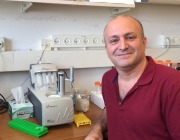Abstract:
Amyloid aggregation is a key process in amyloidoses and neurodegenerative diseases. Hydrophobicity is one of the major driving forces for this type of aggregation, as an increase in hydrophobicity generally correlates with aggregation susceptibility and rate. However, most experimental systems in vitro and prediction tools in silico neglect the contribution of protective osmolytes present in the cellular environment. Here, we assessed the role of hydrophobic mutations in amyloid aggregation in the presence of osmolytes. To achieve this goal, we used the model protein human muscle acylphosphatase (mAcP) and mutations to leucine that increased its hydrophobicity without affecting its thermodynamic stability. Osmolytes significantly slowed down the aggregation kinetics of the hydrophobic mutants, with an effect larger than that observed on the wild-type protein. The effect increased as the mutation site was closer to the middle of the protein sequence. We propose that the preferential exclusion of osmolytes from mutation-introduced hydrophobic side-chains quenches the aggregation potential of the ensemble of partially unfolded states of the protein by inducing its compaction and inhibiting its self-assembly with other proteins. Our results suggest that including the effect of the cellular environment in experimental setups and predictive softwares, for both mechanistic studies and drug design, is essential in order to obtain a more complete combination of the driving forces of amyloid aggregation.
